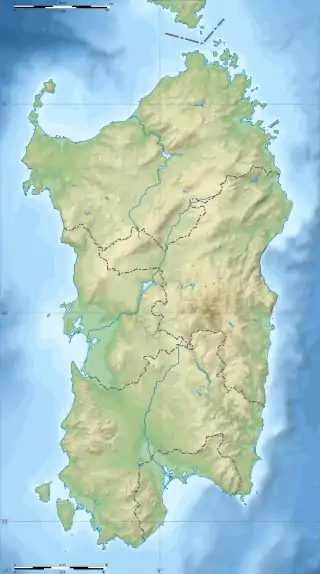Budelli
Budelli is an island in the Maddalena archipelago, near the strait of Bonifacio in northern Sardinia, Italy. It is one of the seven islands that comprise Arcipelago di La Maddalena National Park.[1]


Budelli is located several hundred metres south of Razzoli and Santa Maria islands. It has a surface of 1.6 square kilometres (0.62 sq mi) and an overall coastal span of 12.3 kilometres (7.6 mi). The highest point is Monte Budello, at 87 metres (285 ft).
In antiquity, the Romans used the island. More recently, it was the site of some of the filming for Red Desert, released in 1964. For decades, the island had a series of private owners.[2]
Budelli is one of the most beautiful islands in the Mediterranean Sea, especially renowned for its Spiaggia Rosa (Pink Beach), on the southeastern shoreline,[3] which owes its color to microscopic fragments of corals and shells, such as Miriapora truncata and Miniacina miniacea, and was featured in Antonioni’s 1964 film Il deserto rosso (The Red Desert). Budelli is one of four uninhabited islands in the Maddalena archipelago, the others being Caprera, Spargi, and Razzoli. However, since 1989 the island's permanent caretaker has been Mauro Morandi, who took over from a married couple.[4]
In October 2013, the island was to be sold for €2.94 million to New Zealand businessman Michael Harte, after the bankruptcy of the previous owner. Harte intended to protect the island's ecosystem.[5] The government protested, and after a three year court battle, a judge in Sardinia[6] reverted the island to the state planning to use it for environmental education.
Rules imposed as of the 1990s by La Maddalena NP have not allowed tourists to walk on the pink beach or swim in the sea; however, day trips by boat, as well as walking along a path behind the beach, were permitted.
The sole occupant of the island, Mauro Morandi, who has lived there since 1989, is now to be evicted by the end of 2020.[7] To explain why he could not be allowed to live on the island indefinitely, the park's president said in 2016: "[He] symbolizes a man enchanted by the elements who decides to devote his life to contemplation and custody ... No one ignores his role in representing the historical memory of the place … But it's hard to find a contractual arrangement for a person in his position."[8]
See also
References
- Khan, Gulnaz, Meet the Man Who Has Lived Alone on This Island for 28 Years, National Geographic, retrieved 2017-11-21
- Meet the 79-year-old man who lives alone on an Italian island
- Meet a man who has lived alone on an island for 31 years
- After 30 Years, an Island and Its Sole Inhabitant Face an Uncertain Future -- Mauro Morandi watched tourism, technology, and climate change reshape his home. Now, he fears he won’t see its restoration., Vittoria Traverso, Atlas Obscura/ Slate.com, 2018-03-12
- "Kiwi's Mediterranean island purchase 'no flight of fancy'". The New Zealand Herald. 3 October 2013.
- When an Island’s Lone Caretaker Leaves
- Angela Giuffrida (15 July 2020). "'Italy's Robinson Crusoe' despairs as eviction from island paradise looms". The Guardian.
- When an Island’s Lone Caretaker Leaves